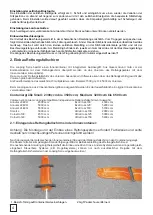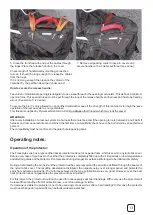
2)
3)
14
15
Behavior in particular cases
During water and strong wind landings the pilot should disconnect himself as soon as possible from the paraglider /
harness after landing. For that please loosen the leg belts and then open the leg and chest buckles. We generally
recommend to carry a webbing cutter!
For tree landings, etc. the pilot should first secure himself against a possible crash and should wait for professional help.
Contrary to above recommendations, it is possible that a different behavior as described is required. The variety of
possible situations not allows an universal or general advise for the right behavior. The right behavior is a case-to-case
decision in full responsibility of the pilot.
Lifetime and replacement of parts, repair advice
The
is designed for high loads and stress. High demands were set in the choice of materials. The
lifetime of the harness depends on a high degree of awareness and treatment of the pilot. We recommend to inspect the
harness periodically for signs of wear. If necessary damaged components must be replaced.
Damaged components may only be repaired by the manufacturer or an authorized workshop. Only original parts are to
be used!
If the harness is dirty, clean it only with water. Avoid mechanical stress as brush and rub. Chemical cleaners will damage
fabric and webbing.
Except the sealing thread no spare part is necessary. An inexpensive purchase is possible through us.
Maintenance, inspection, periodic check:
The
is almost maintenance free but it requires a regular check for damage. Regular inspection gives
you the guarantee of a full function of the harness.
Take particulary care that no dirt gets into the mechanic of the buckles and that all moving parts of the buckle are running
free and are not damaged. If needed you can oil the buckles a little bit.
The maintenence of the protector is described separate.
Storage and transport:
In order to prevent unnecessary weakening of the harness we recommend for storage and transport:
- avoid high temperatures (for example: closed car in summer)
- avoid dealing with fire, sharp objects and chemicals close the harness
- avoid unnecessary long exposure to sunlight as ultraviolet radiation destroys the molecular structure of the material
- avoid contact with salt water or acid liquids
- if the harness is not in use for a long time, especially the back protector should not be stored compressed. Store the
harness in a cool, dry place.
Disposal:
The materials used in a paragliding harness require proper disposal. Please return the worn-out equipment to us. The
equipment will be disposed properly by us.
Nature- and environment friendly behaviour:
Actually it’s self evident, but nevertheless mentioned particularly: Please do our nature near sport in a way which do not
stress nature and environment!
Please do not walk beside the marked ways, don’t leave your litter, don’t make unnecessary loud noises and respect the
sensitive balance in the mountains.
Especially at the take-off we have to take care for the nature!
Freesstyle serie
Freesstyle serie
The harness must undergo at least after 24 months a complete check.
The buckles must be checked on wear and damage (if an inspection instruction of the buckle manufacturer is existing the
buckles must be checked in accordance with its instructions) in order to guarantee faultless function.
The carabiner must be replaced according the carabiner manufacturer instructions, lately after 1000 hours or 5 years.
Only original carabiners are to be used! The periodic check must be documented.


































